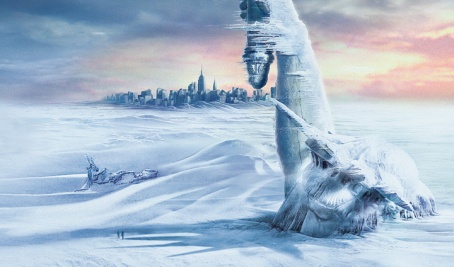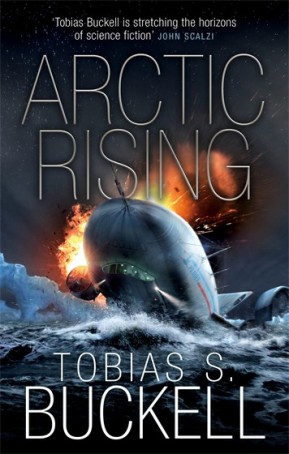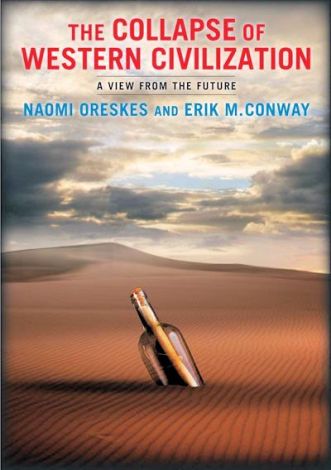Scientists have been developing and enhancing climate models to project possible futures under multiple carbon-emission scenarios since the 1970s. Models from the IPCC resoundingly conclude that average global surface temperatures will continue to rise as greenhouse gas forcing continues. Science fiction allows us to explore these possible futures and examine how the present might shape those possibilities. To better understand a few works of
cli-fi and what they can contribute to our understanding of the present and of the future, I examine three contemporary cli-fi novels; The Day After Tomorrow (Emmerich 2004), Arctic Rising (Buckell 2012), and The Collapse of Western Civilization (Oreskes & Conway 2014). All three works of cli-fi use, to varying degrees, scientific projections of future climate scenarios and explore how humans and non-human systems might respond. Each work focuses on different possible futures (ice ages to water worlds) and explores climate change as a catalyst for massive social, political, economic, and ecological transformation.
3 Synopses
The Day After Tomorrow (2004 film)

After years of exploitative and shortsighted manipulation of natural resources, humanity faces the wrath of the natural world. A 10-day megastorm sweeps across the Northern Hemisphere and launches the world into another ice age. According to protagonist and paleoclimatologist, Jack Hall, changing ocean currents caused by the melting of polar ice caps have created conditions to catalyze this extreme weather event. As minor squabbles between characters are sprinkled throughout the script, the storm takes center stage as the film’s primary villain and unites all other characters as humanity struggles to survive. Once the eye of the storm dissipates, members of the “developed world” are now guests in the global south, survivors who took shelter in the top floors of NYC skyscrapers are rescued, and the once-dominant ethic of unchecked exploitation of nonhuman resources is replaced with a humbled appreciation for humanity’s inability to control and suppress planetary systems.
Arctic Rising (2012, literary fiction)

In the not-too-distant future, the polar ice caps have broken up and the Arctic Circle has become a boomtown with offshore oil drilling operations, cities afloat on reclaimed military airstrips, and small, self-declared nation states emerging on the last remaining glaciers. As a region situated in international waters, the Arctic Circle is a hot spot for illegal nuclear waste dumping, drug trafficking, and unregulated factories. Anika, an agent for the United Nations Polar Guard (UNPG) is responsible for monitoring boat traffic in the area to catch illegal behavior, primarily nuclear dumping. After discovering radioactive cargo on a ship, Anika’s life is threatened and she must summon all of her military training to outwit and overpower her would-be killers and captors. Against the backdrop of continued global warming and changing geopolitical dynamics, Anika and her allies learn that a private company has taken the fate of the world into their hands. While the plot is upheld by fast-paced action and combat, attention is given to governance structures, competing ethical ideals, and market failures leading to ecological collapse. Based on real world projections produced by the US Navy, Arctic Rising (2012) is Tobias Buckell’s take on a human-centered narrative in a nearly ice-free North Pole.
The Collapse of Western Civilization (2014 literary fiction):

A senior scholar writing from the Second People’s Republic of China in the year 2393 documents the catastrophic dynamics of the 20
th and 21
st centuries that led to a collapse of western civilization by the late 21
st century. The Collapse of Western Civilization (CWC) (Oreskes and Conway 2014) portrays the scientific, political, and economic systems and beliefs that obstructed necessary action to avert climate crises. Drawing on the extensive paper and digitally recorded accounts of the events leading up to the Great Collapse, the narrator describes the nearly unbelievable history of a civilization’s demise that was “not only predictable, but predicted,” (p. 1). Written as a textbook for students in 2393, this essay-turned-book explores how future scholars might reconstruct and understand the socio-politico-economic systems that doomed western civilization to failure.
The Science in the Fiction
All three pieces use scientific projections of climate change to inform their work and to imagine ways that humans might overcome and adapt to immense changes in Earth systems. Because The Day After Tomorrow (DAT) uses an extreme weather event as the basis for its plot, the scientific merit of this particular fiction is most questionable. While real-life climatologist Dr. Stefan Rahmstorf writes that the climatic changes depicted in the film are possible, they would not occur in the time frame of a 10-day storm (2004). Arctic Rising and CWC, however, do not use extreme weather as the major source of drama, and therefore do not need to embellish, speed up, or fabricate climatic events. In Arctic Rising, the Arctic North is ice-free. When author Tobias Buckell first starting writing the book in 2008, an ice-free Arctic seemed like a distant possibility and unlikely to occur within his lifetime, according to the Navy reports he used while researching the subject. By the time the book was published in 2012, however, ice-free summers “are a given very soon,” (p. 302).
Adapting to and Solving Climate Change
In all three climate fictions examined here, human civilization survives monumental climate changes. Although each tale includes large numbers of human deaths (probably millions or billions), by rising sea levels and changing temperatures, there are humans who carry on. Written by science historians, CWC has the most detailed and scientifically plausible descriptions of possible attempts to curb global warming and what surviving populations might look like. As a runaway greenhouse effect continues to warm the Earth throughout the 21
st century, according to the historian in CWC, one geoengineering solution to reduce solar radiation is implemented. The international community agrees to inject submicrometer-size sulfate particles into the atmosphere to reduce average global temperatures by .1 degrees C per year. While the plan initially works, untoward side effects cause the international community to end the effort and a phenomenon called
termination shock causes more rapid temperature increases. Permafrost ten melts, and the carbon load in the atmosphere is more than doubled. Only after a renegade release of a carbon-eating lichenized fungus, does atmospheric CO
2 stabilize and, subsequently, atmospheric temperatures. While the populations of Africa and Australia are wiped out, survivors from Europe, Asia, North America, and the higher altitudes of South America, regroup and rebuild after this stabilization (p. 33).
While warming has occurred in Arctic Rising, leading to an ice-free Arctic, destabilized populations caused by rising seas are only hinted at. A detective that assists Anika is from the Carribean and his personal connection to the effects of global warming are repeatedly hinted at as a motive for his drive to remain with Anika on her mission through great adversity. In response to the runaway greenhouse effect, a private corporation, Gaia, Inc., is releasing reflective orbs into the upper atmosphere to reflect the sun’s rays in an attempt to reverse global warming. The cost of enacting such a plan in the real world is so expensive and the effects so unpredictable, the international community is unlikely to approve it. Which is why, in Arctic Rising, one of the wealthiest corporations in the world has decided to enact this geoengineering plan on their own. In an attempt to reverse global warming, Gaia, Inc. is releasing reflect orbs into the upper atmosphere and to reduce the solar radiation that reaches Earth’s surface. Similar to CWC, where one renegade Japanese scientist releases the lichenized fungus to transform atmospheric CO
2, the geopolitical atmosphere in Arctic Rising does not unilaterally approve of implementing this solution. And unlike either of the other two stories, the humans in DAT have no time to implement any strategy to avert the climate catastrophe caused by the megastorm. They can only do their best to survive the storm and to regroup in its aftermath. While legitimate scientific projections and possible solutions inspired these works, the realistic incorporation of science in climate-related adaptation is variable.
Role of Nature and Animals
More so than in any other work, DAT portrays Nature as a character with a will of its own. The relationship between humans and Nature is clear in the film: humans have caused Earth systems to become imbalanced and Nature is drastically shifting to reach a new equilibrium. In contrast, Nature in Arctic Rising is a backdrop to the human drama. While global warming is upsetting geopolitical order and inspires Gaia Inc. to launch a solar reflecting initiative, the people in the Arctic are benefiting from climate changes and ‘climate change’ is not an adversary to most of the characters (except for the one who is concerned for his family in another part of the world).
In CWC, the role of nature is nebulous. It is unclear whether the diseases and migration caused by global warming are considered nature because the phenomenon is so clearly caused by human activity. Rising sea levels ignite mass migrations and conflict, a Second Black Plague emerges in Europe sometime in the late 21
st century, killing over half of Europe’s population and spreading to North American and Asia. While these events are traced back to the Great Collapse of polar ice sheets, which themselves would be considered nature, their collapse would be considered anthropogenic, not natural. So, as in the other two stories, nature has been abused by human exploitation and it is this exploitation that leads to ecological collapse.
None of these works focus particular attention on animals’ response to climate change, but in both CWC and DAT, animals serve as a warning and, sometimes, a threat. In CWC, year 2023 is remembered as the “year of perpetual summer” that resulted in widespread deaths of livestock and companion animals.
“The loss of pet cats and dogs garnered particular attention among wealthy Westerners, but what was anomalous in 2023 soon became the new normal…A shadow of ignorance and denial had fallen over people who considered themselves children of the Enlightenment. It is for this reason that we now know this era as the Period of the Penumbra.” (p. 9)
Flocks of migrating birds alert observant characters in DAT that troubling changes are on their way. As the water inundates a shelter for animals, caretakers marvel that the wolves have escaped while all other species face certain doom. Wolves take on
Climate Change and Culture Change
Migration, massive decline in human population, and an altered climate redefines where and how people live on the Earth. An ice-free Arctic as depicted in Arctic Rising has created a rapidly developing settlement with industry and institutions that thrive in a climate of lawlessness. The most powerful nations are referred to as the Arctic Tiger, comprised of Finland, Norway, Greenland, Iceland, Russia, Canada and Alaska. Climate changes have also led to the rise of companies whose products are intended to curb anthropogenic greenhouse gas emissions. The most powerful of these companies are referred to as the Green Giants, of which Gaia Inc. is part. Similarly to Arctic Rising, the power and influence of a capitalist economy and private business are emphasized in DAT. Adherence to the economic dogma of unlimited growth is blamed for the warming that causes the megastorm. In the final moments of the film the Vice President of the United States humbly declares, “For years we operated under the belief that we could continue consuming our planet’s natural resources without consequence. We were wrong.
I was wrong.” With this statement, a major cultural shift toward stewardship and sustainability is implied. In CWC, free-market capitalism and the US government do not survive. Neocommunism rises in the aftermath of the Great Collapse (2073-2093). While capitalist nations vehemently opposed communism, it was the greater capacity for communist regimes to relocate their populations that saved this political system. All three fictions explore cultural and geopolitical shifts that could occur as a result of major climatic shifts and the extent of the shifts depends on the time period and intentions of the authors/filmmakers.
Ethics in Climate Fiction
Applicable ethical frameworks are most closely scrutinized in DAT and Arctic Rising. Viewers of DAT might be surprised when any friction between characters is completely absolved by the time the eye of the storm is passing over New York City. Soon after the enormity of the storm is realized, all human characters join together to increase human survival rates. In Arctic Rising, competing ethical frameworks turn out to be the primary cause of conflict in the story. Anika, the protagonist, is concerned with the well-being of individuals and all her efforts to pursue her dangerous missions are based on the strong ethical impulse to protect individual humans. A mastermind behind Gaia Inc., the company launching a geoengineering project to reverse climate change, is, conversely, concerned with systems and lacks concern for individual humans or animals. He is perfectly willing to inflict harm on and kill those who oppose his geoengineered solution. In the end, Anika concludes that solutions of this magnitude must be democratically decided and that individual lives must be honored and considered. Her character is staunchly opposed to an ethical framework based on the ends justifying the means.
Authors’ Intent
Jeffrey Nachmanoff, co-writer for DAT, said in a 2004 interview that hoped the film would inspire dialogue on this important topic. This general sentiment is echoed by Oreskes and Conway, authors of CWC. In an interview included in the epilogue of the book, Conway says, “At best we can hope to have helped (readers) think about the climate of the future,” (p. 79). And Oreskes continues, “You can’t predict what readers will take away. Books are like a message in a bottle. You hope someone will open it, read it, and get the message. Whatever that is,” (p. 79). Both Oreskes and Conway are historians of science at respected educational institutions (Harvard and CalTech, respectively) and so their treatment of the topic is rooted in their decades-long investigation of the role(s) science plays in popular culture and, in particular, in climate change. Tobias Buckell, author of Arctic Rising, researched climate projections and political shifts related to climate change using Navy reports. According to his website and the acknowledgments in his book, he is interested in ‘around-the-corner ecological futures’ and this general interest inspired Arctic Rising. It appears that inspiration for all three of these works came from a desire to simultaneously entertain and to encourage dialogue on climate change.
Conclusion
These three works provide entry points for nuanced discussion of potential effects climatic changes may have on our world. Far from the sterile graphs depicting warming surface temperatures over most parts of the globe, these works explore how economic, political, and personal relationships may transform as sea levels rise, temperatures change, and geopolitical power dynamics shift. Extrapolating on scientists’ best guesses for climatic changes through a futurist, fictional lens allows writers to explore future scenarios that climate models cannot account for. While climate modelers struggle to discover which biophysical inputs make significant changes on Earth’s systems, fiction writers strive to understand what elements of human culture will be encouraged or stifled in a vastly different world. Neither the climate modelers nor the fiction writers have a crystal ball to predict what the human world will look like beyond year 2100, but collaborations between these minds can, at the very least, give us frameworks for discussing what
might be and how we could prepare for these future possibilities.










